Once upon a time, there was a barber named Hím, and he was super poor. He had a wife and twelve kids – five boys and seven girls! Sometimes he would earn a little bit of money. One day, he was feeling really grumpy and left his family to figure things out on their own. “What can I do?” he said to himself. “I don’t have enough money to buy food, and my kids are crying because they’re hungry!” So he walked and walked until he got to a jungle. It was nighttime. This jungle was called the “Tigers’ Jungle” because only tigers lived there. No birds, no bugs, no other animals – just four hundred tigers! As soon as Barber Hím got to the jungle, he saw a big tiger walking around. “Oh no!” he cried. “This tiger is going to eat me for sure!” He grabbed his razor and the leather strap he used to sharpen it and started making his razor really sharp. Then he walked right up to the tiger, still sharpening his razor.
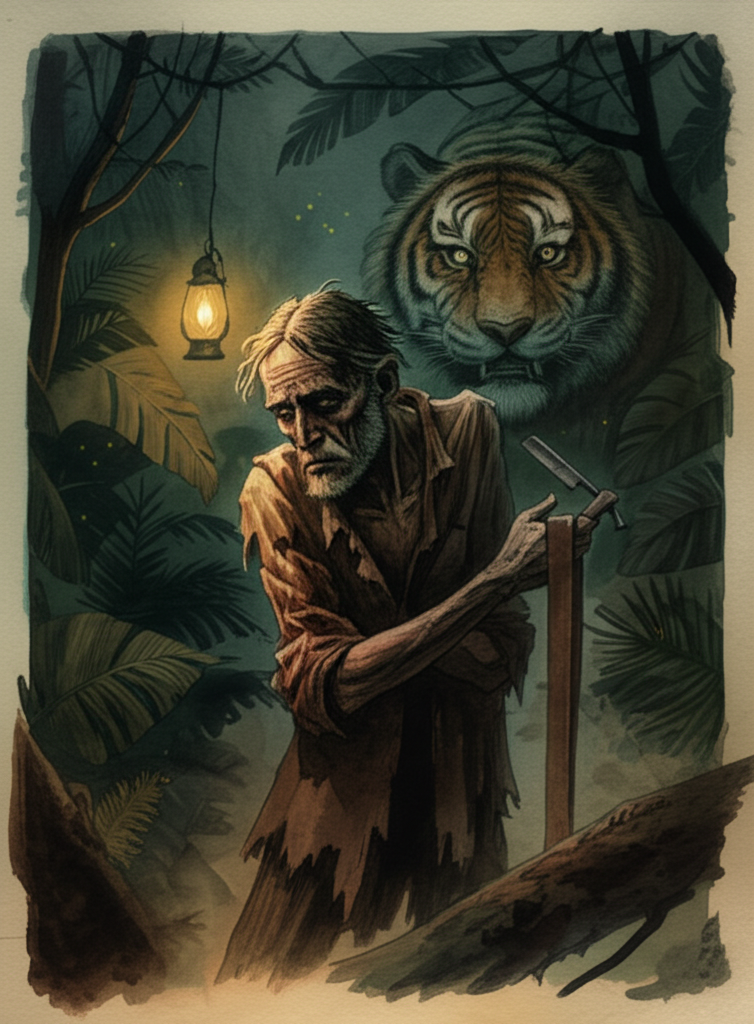
The tiger got really scared. “Uh oh,” said the tiger. “This guy is going to cut me!” “I’m here,” said the barber, “to catch twenty tigers! The King wants me to! You’re one of them, and I need nineteen more!” The tiger was super worried. “If you don’t catch us,” he said, “I’ll give you all the gold and jewels you can carry!” You see, these tigers used to sneak into villages and take people, and some of those people had money and jewels. The tigers kept it all together. “Okay,” said Hím. “Then I won’t catch you.”
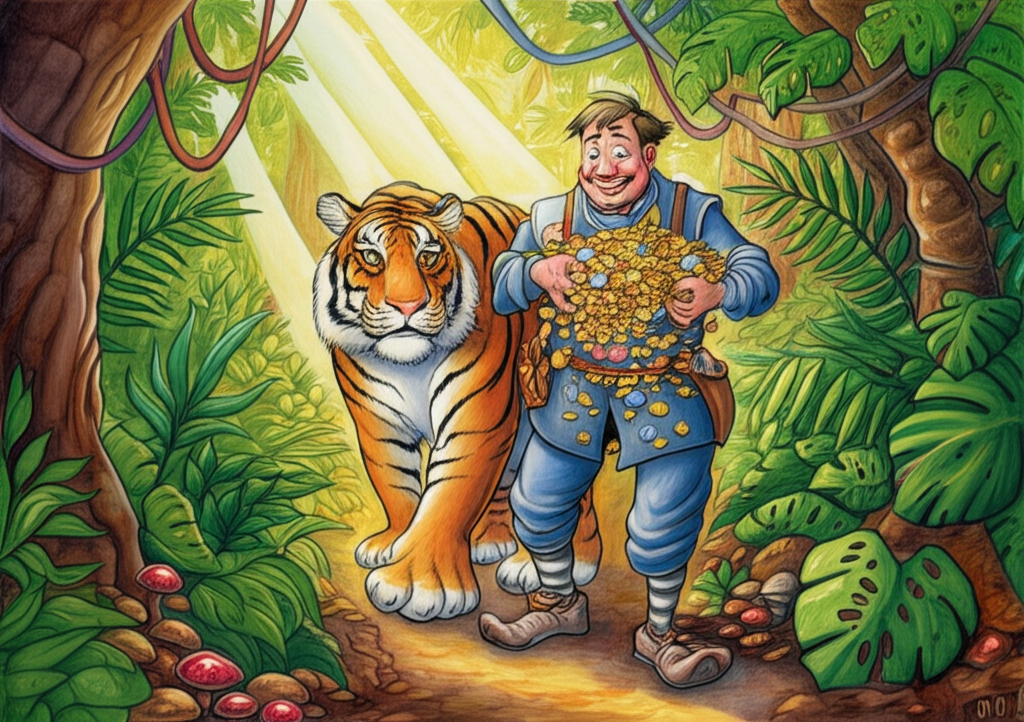
The tiger took him to the place where all the tigers ate their dinners, and the barber grabbed as much gold and as many jewels as he could carry and went home.
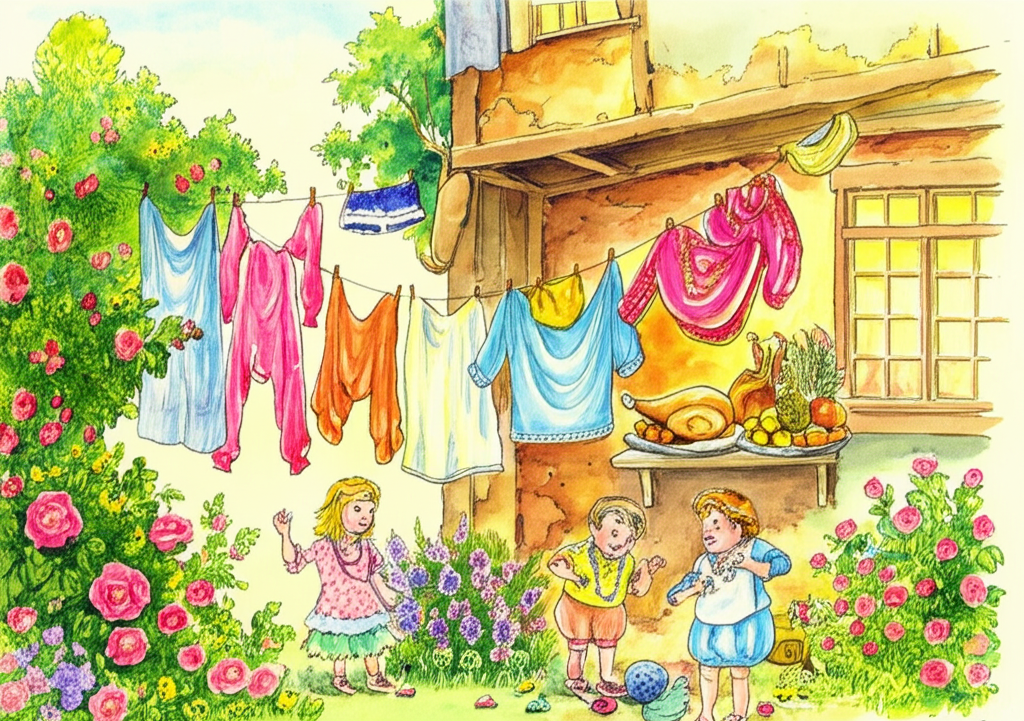
He built a house, bought his children nice clothes and yummy food, and shiny necklaces. They all lived happily for a while. But then he wanted more money, so he went back to the Tigers’ Jungle. He met the tiger again, and he told him the King had sent him to catch twenty tigers. The tiger was terrified! “If you promise not to catch us,” he said, “I’ll give you even more gold and jewels!” The barber agreed, and the tiger took him to the same spot, and the barber took all the jewels and money he could carry. Then he went home again.
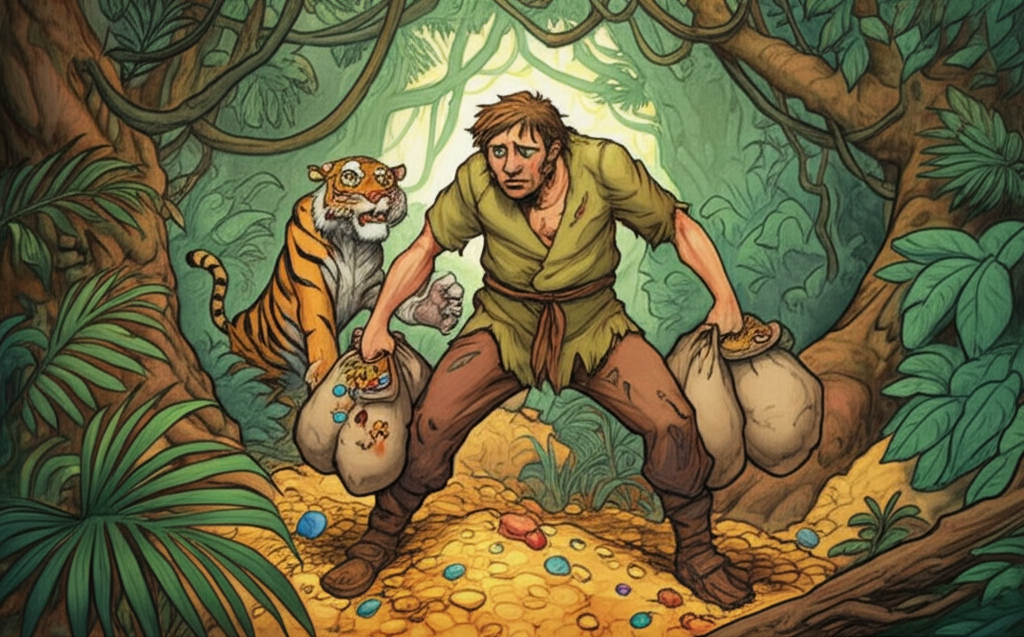
One day, a really poor man, a beggar, asked him, “How did you get so rich? You used to be so poor you could barely feed your family!” “I’ll tell you,” said Hím. He told him all about his trips to the Tigers’ Jungle. “But don’t go there to get gold tonight,” said the barber. “Let’s go and listen to the tigers talking. You can come with me if you want. But you can’t be scared if they roar!” “I won’t be scared,” said the beggar. So that night at eight o’clock, they went to the Tigers’ Jungle.
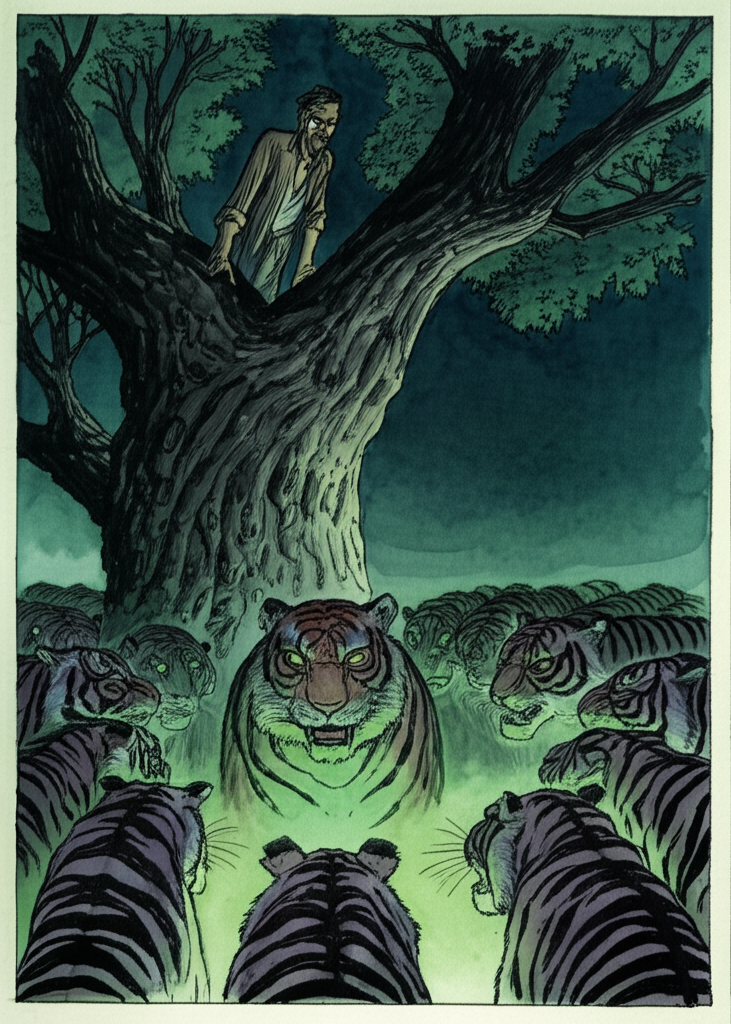
The barber and the beggar climbed up into a tall, leafy tree. The leaves covered them up like they were inside a house. The tigers always had their meetings under this tree. Soon, all the tigers in the jungle came together under the tree, and their King – a huge, scary tiger with only one eye – came too. “Brothers,” said the tiger who had given the barber the money and jewels, “a man has come here twice to catch twenty of us for the King! There are only four hundred of us now, and if twenty get taken away, we’ll be a small group! So, I gave him all the money and jewels he could carry each time, and he left. What should we do if he comes back?” The tigers said they would meet again tomorrow and figure it out then. Then the tigers left, and the barber and the beggar climbed down from the tree. They grabbed lots of money and jewels and went home. “Tomorrow,” they said, “we’ll come back and hear what the tigers say.” The next day, the barber went to the Tigers’ Jungle by himself. He met his tiger again. “This time,” he said, “I’m here to cut off the ears of all four hundred tigers in this jungle! The King wants them to make medicine!” The tiger was even more scared than before. “Don’t cut off our ears! Please don’t!” he begged. “We won’t be able to hear, and it will hurt so much! Go and cut off all the dogs’ ears instead, and I’ll give you enough money and jewels for two men to carry!” “Okay,” said the barber. He made two trips carrying money and jewels from the jungle to the edge of his village, and then he got someone to help him carry them to his house. That night, he and the beggar went back to the big tree where the tigers held their meetings.

The tiger who had given the barber so much money and jewels had made a big pile of food – meat, chickens, geese, people the tigers had killed – everything he could find! He put it under the tree because he thought the tigers would want to eat after their meeting. Soon, the tigers arrived with their King. The barber’s tiger said, “Brothers, what are we going to do? This man came back today to cut off all our ears to make medicine for the King! I told him that would be bad for us, and he should cut off all the dogs’ ears instead. I gave him enough money and jewels for two men to carry. So, he went home. Now what should we do? We have to leave this jungle! Where will we go?” The other tigers said, “We won’t leave the jungle! If that man comes back, we’ll eat him up!” Then they ate dinner and went away, saying they would meet again tomorrow. After the tigers were gone, the barber and the beggar climbed down from the tree and went home without taking any money or jewels. They decided to come back the next night. The next night, they came back and climbed into the big tree. The tigers came too, and the barber’s tiger told his story all over again. The tiger King sat up straight and said fiercely, “We won’t leave this jungle! If that man comes back, I will eat him myself!”
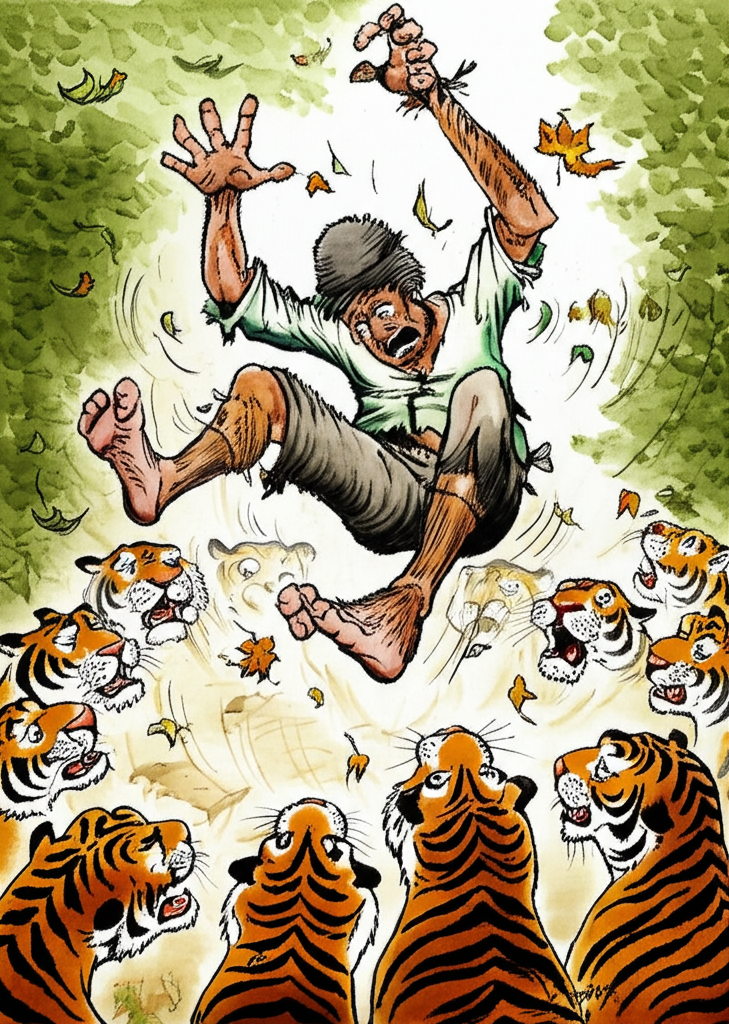
When the beggar heard that, he was so scared that he fell out of the tree right into the middle of the tigers! The barber quickly yelled in a loud voice, “Now cut off their ears! Cut off their ears!”
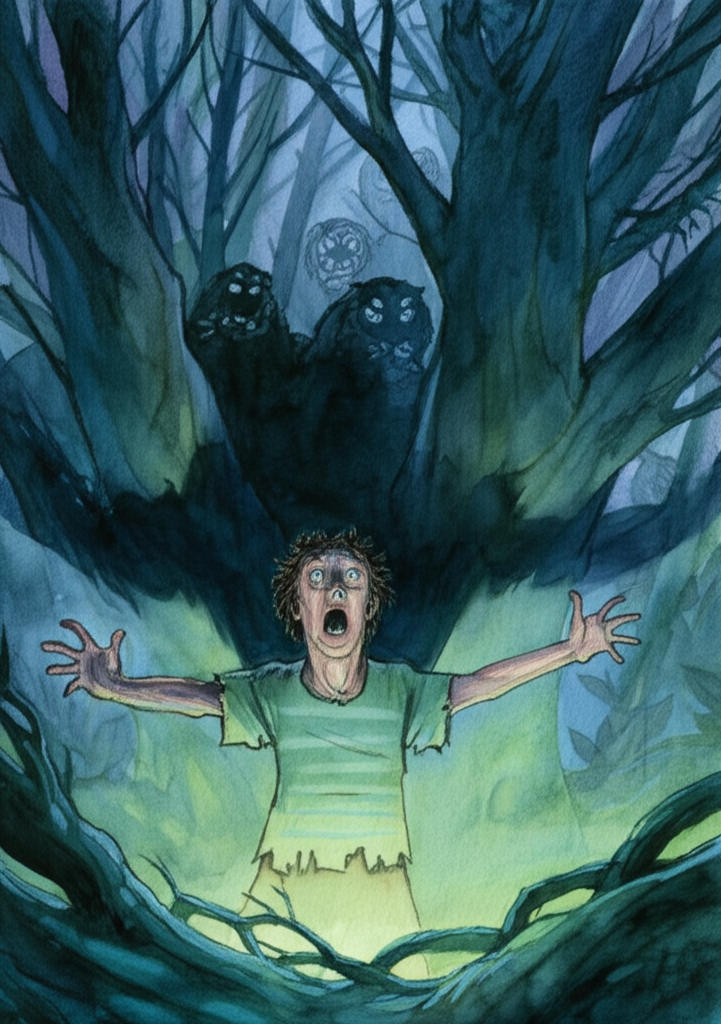
The tigers were so terrified that they ran away as fast as they could. Then the barber took the beggar home, but the poor man was hurt so badly from the fall that he died. The barber lived happily ever after, but he was very careful never to go to the Tigers’ Jungle again.